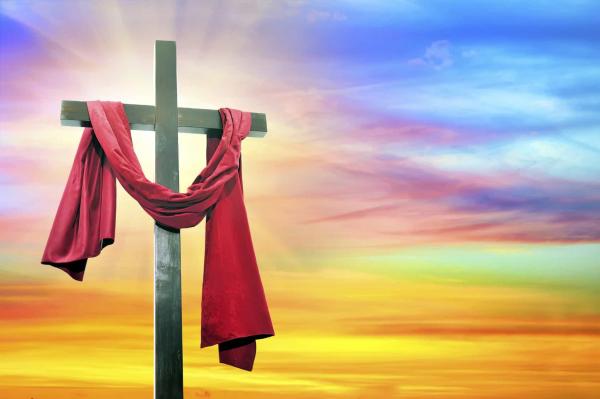
Easter is the day Jesus' resurrection is celebrated. However, there are three other days, often seen on calendars but not always understood, that are important as well. Following is a short synopsis explaining those long ago events and their significance.
Palm Sunday
The Sunday before Easter is known as Palm Sunday, the commemoration of Jesus' triumphal entry into Jerusalem and the fulfillment of ancient prophecy.
On the day that would eventually be called Palm Sunday morning, Jesus started walked from Bethany, where he had been staying with friends, to Jerusalem, a distance of less than two miles. As he neared the city, he instructed two of his apostles to procure a donkey colt for him to ride on. He explained where they should go and what they should say to the owner of the donkey. They followed his instructions and the donkey was obtained. Jesus then rode the donkey into the city.
Jesus riding on a donkey, as opposed to a horse, was significant. Anciently, a king riding a horse meant he wanted to overthrow a nation. But when a king rode a donkey, it signified peace. So Jesus, the king of kings, entering Jerusalem on this animal of peace, fulfilled Isaiah's prophecy of the Savior being a "Prince of Peace." He also fulfilled Zechariah's prophecy of the Messiah riding upon a donkey's colt before saving the earth's inhabitants.
When Jesus came to the city, many people who had heard he was coming used their cloaks andpalm branches to pave his way along the road. When they saw him, they shouted in joy, "Hosanna!" Their shouts signified that these individuals recognized Jesus as the long-promised Messiah.
The Passover and Last Supper
This day is significant for both Jewish and Christian faiths. The Passover is the oldest and one of the most revered in Judaism. It commemorates when God delivered the Hebrews, Jewish ancestors, from slavery in Egypt. Although the exact date is unknown, approximately 4,000 years ago the Hebrew people were placed in bondage to their Egyptian masters. After several hundred years of slavery, Moses led the Hebrews out of Egypt and into freedom. The popular movie, "The Ten Commandments," dramatizes these events and tells many of the difficulties the Hebrew people underwent in order to leave Egypt.
Since then, the Passover has been a time when Jews remember the miracle of their forefathers' deliverance by eating a special meal together. This tradition was also true during Jesus' time in ancient Israel. The day before he was crucified, he and his disciples took part in a Passover meal at an event now known as the Last Supper or Maundy Thursday.
It was at this meal, when Jesus was with his disciples, that he washed their feet, foretold Judas' betrayal and Peter's denial of him. This was also the meal at which Jesus gave his great commandment of loving others as he had loved his disciples; it would also be the last time he ate with his disciples before being crucified.
After their meal together Jesus and his disciples went to the olive grove, known as Gethsemane. Here his solitary suffering was sointense that blood came from his pores. Soon after, his disciple-turned-traitor, Judas, arrived with armed guards to arrest Jesus and take him to the Sanhedrin.
Good Friday
The day Jesus was crucified is known as Good Friday. On this day Jesus was taken to the high priest's palace and there, in front of a large assembly of the highest Jewish leaders of the Sanhedrin, was struck and decreed guilty of death. He was then sent to Pilate, the Roman governor to receive a governmental death decree.
After questioning him, Pilate realized Jesus was from the Galilee area and not technically under his jurisdiction, so he sent him to Herod the king. Herod then questioned Jesus, had his soldiers mock him and sent him back to Pilate, instructing him to settle the matter.
Pilate still believed Jesus to be innocent, but he also knew many high-ranking individuals desired his death. So Pilate had his soldiers scourge Jesus. As part of their mockery they made a crown of thorns, placed it on Jesus' head and arrayed him with a purple robe; thereby scorning the title King of the Jews many had given him.
It was the tradition for the governor to release a prisoner during Passover time. Pilate asked the crowd if they wanted Jesus or another prisoner, whose name was Barabbas, to be released. Encouraged by the chief priests and elders in the crowd, the people chose Barabbas to be released and insisted upon Jesus' crucifixion. Giving in to their demands, Pilate literally washed his hands of the whole affair and agreed to crucify Jesus.
Jesus was then taken to a place called Golgotha, also known as Calvary. Here, his coat was removed and he was hung in the middle of three crosses. Two others were crucified that day, both of them thieves. After being on the cross for several hours, Jesus finally died. The soldiers, wanting to make certain he was truly dead, stabbed him in his side.
When his body was removed from the cross, it was taken by a man named Joseph of Arimathaea and laid to rest in a sepulcher. Because the Jewish Sabbath began that evening and there was a time constraint, Jesus' friends were unable to properly prepare his body for burial according to custom. So they decided to return the morning after the Sabbath to finish their preparations.
Little did they know when they returned that Easter morning that his body would be gone. Jesus had risen.

